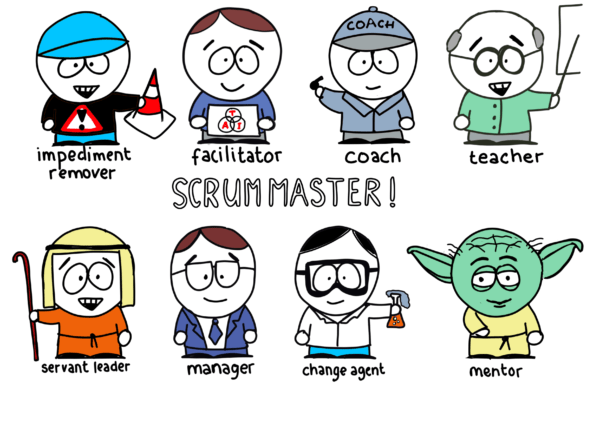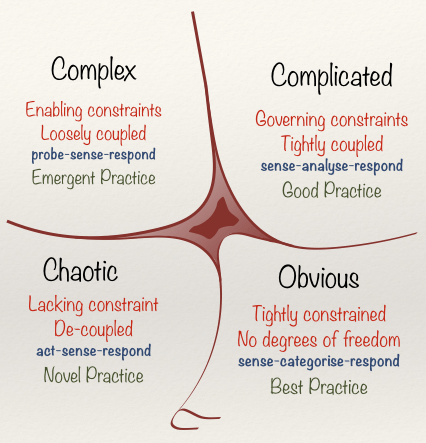
The Scrum Master is a servant-leader for the scrum team & helps outsiders in understanding scrum. Scrum Master tools helps him/her to effectively perform this role. He is a coach & mentor for the scrum team. Coaching is unlocking a person’s potential to maximize their own performance. Mentoring transfers your agile knowledge and experience to the team as that specific knowledge becomes relevant to what’s happening with them.
Scrum Master Tools and Techniques
Leadership Style
Leader as Expert: The manager (leader) is the most knowledgeable person who is supposed to give orders to workers and is responsible for planning, allocation of resources, and overall people organization. Technically proficient in one or more knowledge areas or domains.
Leader as Conductor: Doesn’t provide the technical solution but instead orchestrates the activities of the organization to achieve the desired objectives.
Leader as Developer: People at each level can solve most of their problems by themselves. So don’t give orders rather encourage them to come up with solutions and take over responsibility for running the company. Helps the team realize their fullest potential.
Team Development
Tuckman’s Group Development
- Forming: The ScrumMaster’s role at this stage is to explain the backbone Scrum principles and start the transformation, not only on paper but in the team’s heads—to lift them out of their habits. Direct the team, and establish clear objectives, both for the team as a whole and for individual team members.
- Storming: The ScrumMaster’s role is to encourage them to talk and make working agreements on how they are going to act together. A most important aspect of the ScrumMaster is facilitation. Establish processes, structures, build trust, resolve conflicts, coach team on assertiveness and conflict resolution skills.
- Norming: The role of the ScrumMaster is to show the team ways to get even better. Encourage them to take ownership and responsibility and continue improving. A most important aspect of the ScrumMaster is coaching. Help team members to take responsibility for progress towards the goal.
- Performing: The role of the ScrumMaster is to prevent things from going wrong and avoid the team from returning to any previous stage. Always observe and be ready to step in as coach, facilitator, or impediments remover or to share experiences and teach the team new things. Finally, delegate tasks and projects as far as you can.
- Adjourning or Change: Take the time to celebrate the team’s achievements. The role of the ScrumMaster’s role must be to observe any change and to identify it early and adjust his behavior regarding the actual team stage, even if it’s just for a couple of days.
Absence of Trust, Fear of Conflict, Lack of Commitment, and Avoidance of Accountability & Inattention to Results are signs of dysfunctions. Blame, Defensiveness, Stonewalling & Contempt are results of dysfunctions.
Scrum Master Tools: Problem Solving
Cynefin Framework

Cynefin means habitat or place of multiple belongings. Therefore first classify problems and situations and based on those classifications, decide what approach to take. Then categorizes problems into five domains:
- Simple: Problems are simple, the relationship between cause and effect exists, is predictable in advance so the solutions are also simple. Apply a predefined best practice solution. Sense – Categories – Respond. For example Interest on a provider claim needs to be calculated. Best practice needs to be applied in terms of predefined formulae and given input the results are always the same.
- Complicated: Require some analysis to classify them so apply good practices that are well planned. Anything that can be solved with professional training or external consulting services. Hence use Sense – Analyze – Respond model. For example For a web portal development what will be the language to use (ie. .Net or Java or HTML).
- Complex: Neither simple nor complicated so allow emergent practices like implement Kaizen and regularly run experiments each Sprint. Hence use Probe – Sense – Respond model. For example Most types of innovation. Professional training or best practices are replaced with probing different approaches and ideas, sensing the results/feedback to see what works and what doesn’t, and responding appropriately (by amplifying and dampening our probes).
- Chaotic: Completely unpredictable, and every attempt to control it fails. Therefore use a two-stage approach, stop bleeding then determine the root cause & a solution. Hence use Act – Sense – Respond model. For example Software release failure, production run for payment to providers/members, etc. impacted.
- Disorder: It’s a combination of all of the above. It’s in your comfort zone, but it often fails. So you have to use the approach you are used to.
SHU-HA-RI
Japanese martial arts is the concept of mastering Shu Ha Ri.
Shu – Follow the rule, In Shu, we repeat the forms and discipline ourselves so that our bodies absorb the forms that our forebears created. We remain faithful to these forms with no deviation.
- Drill individual practices.
- Follow recommendations.
- Don’t give up; it works the way it is described.
- Be patient; it will take time to train your muscle memory.
Ha – Break the rule, in the stage of Ha, once we have disciplined ourselves to acquire the forms and movements, we make innovations. Hence in this process, the forms may be broken and discarded.
- Inspect and adapt, create your own deviations, but keep the original meaning and philosophy.
- Go for a deep understanding of purpose.
- Think about practices, concepts, and frameworks in context, how they support or contradict each other.
Ri – Be the rule, in Ri, we completely depart from the forms, open the door to creative technique, and arrive in a place where we act in accordance with what our heart/mind desires, unhindered while not overstepping laws
- Learn from your own practice and experience.
- Develop and share new concepts, and teach others
Scrum Master Techniques Implementing Change
- Create a Sense of Urgency: Show the pain & be honest, transparent in presenting both the opportunities and the threats; otherwise, you might lose the trust of others.
- Guiding Team: Focus on early adopters and encourage them to become part of your team.
- Change Vision: Present the change clearly and simply so people understand it.
- Understanding and Buy-in: You need to be patience with good listening skills, an understanding of others context, and the ability to fill them with enthusiasm.
- Empower Others to Act: Empower others to act, you need to remove impediments so that you can make it easier for them to change.
- Short-Term Wins: Demonstrate success frequently.
- Don’t Let Up: Perfection is not a state, it’s a journey. Changes never stop. Hence the goal can be extended and adapted, but there is never an end.
- Create a New Culture: Make the new way of working an integral part of your culture.
Scrum Master Tools: Root Cause Analysis
There are many Scrum Master Tools on Root Cause Analysis e.g. Fishbone, Five Whys, Multi-attribute analysis etc.
Fishbone
Asking what, where, when, who, and why something is happening.
Example: Team is not predictable. Never know when the product will be ready.
What makes the team unpredictable?
Changes coming through all the time.
Where do the changes come from?
Normally from the business, who is the visionary of the product, and a bit from our users, but those are usually minor changes.
When is the most critical time?
When marketing wants insights in order to prepare campaigns, compliance with a federal mandate and forces us to commit to a certain functionality several Sprints before the product launch.
Who can influence that?”
Our Application Owner, who might be more present during the release and make his comments at every Sprint Review.
Why is he not present at each Sprint Review?
He joined the first few reviews, but we didn’t deliver much functionality at that time, so he gradually stopped coming. Maybe it’s time to invite him again.
Five Whys
In order to identify the true root cause, ask “Why?” five times. It has a few simple steps
- State the problem
- Ask a question about the problem
- Continue to ask “Why?”
- Recognize the root cause
Benefits: Gets to the heart of the issue quickly so the underlying root cause can be found quickly.
Limitations: Single path considered but other paths are not explored fully.
Example: Our product has low quality. We have too many bugs.
Why do you have so many bugs?
Because we don’t test.
Why don’t you test?
We do test in some cases, but because the system is very complex, we can’t understand how every possible scenario works.
Why don’t you understand it?
We don’t know how the users are using the system.
Why don’t you know how the users are using the system?
We’ve never seen our users or asked them for feedback.
Why have you never asked them for feedback?
Because we thought it was the Product Owner’s job to do it.
Multi-attribute analysis
To evaluate multiple solutions against weighted criteria and assign a value relative to others. There are four steps
- Framing of the decision and identification of the goals and objectives to be achieved by the decision maker
- Identification of all decision alternatives and any related attributes that address the decision-making objectives
- Specification of preferences, both for each of the individual attributes and between the attributes in the framework
- Ranking of the decision alternatives according to the specified preferences, given the attribute data for each of the alternatives
Benefits: attribute analysis: Many factors measured at a time using matrix. Multiple criteria allow comparing solution side by side.
Limitations: As there are many factors sometimes all can’t be quantified and works on assumptions about factors and criteria.
Force-field analysis
Use a blank sheet of paper or a whiteboard, or download our worksheet and follow these five steps
- Describe Your Plan or Proposal for Change – Define your goal or vision for change, and write it down in a box in the middle of the page.
- Identify Forces For Change – Think about the kinds of forces that are driving change. These can be internal and external.
- Identify Forces Against Change – Brainstorm the forces (internal & external) that resist or are unfavorable to change.
- Assign Scores – Score each force, from, say, one (weak) to five (strong), according to the degree of influence each one has on the plan, and then add up the scores for each side (for and against).
- Analyze and Apply – To decide whether or not to move forward with the decision or change. To think about which supportive forces you can strengthen and which opposing or resisting forces you can weaken, and how to make the change more successful.
Benefits: Comparison can be drawn because it captures both positive and negative factors.
Limitations: Not suitable for complex solution.
Impact Mapping
Impact mapping is a strategic planning technique that prevents organizations from getting lost while building products and delivering projects, by clearly communicating assumptions, helping teams align their activities with overall business objectives and making better roadmap decisions. Create a mind map in answer to the following questions:
Why are we doing this?
Start with a goal. It should be SMART: specific, measurable, achievable, and agreed, realistic, and timed.
Who can produce the desired effect?
Focus on actors—who can support you and who can obstruct the desired effect? Who will be impacted by it?
How should our actors’ behavior change?
Investigate the actors’ impact—how the actors from the previous step can help you to achieve the goal or prevent you from achieving success.
What can we do to support the impact?
Think about the desired outcome and deliverable. What can you do to make them happen?
